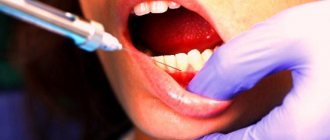Consultation with a doctor A pregnant woman is bombarded with myths from all sides about what can and cannot be done during this period. These superstitions even affect dental procedures. Pregnant women, listening to outside advice, refuse pain relief while undergoing gum treatment and endure pain, or try to avoid visiting the dentist altogether. But often such myths are completely inconsistent with modern reality. The article will help you figure out whether it is possible to treat teeth during pregnancy, remove them, take x-rays, give painkillers, or perform prosthetics.
Is it possible to treat teeth during pregnancy?
Most dentists will answer that teeth can not only be treated during pregnancy, but should also be treated if such a need arises. After all, caries, gum inflammation and other problems cause not only discomfort, but can also provoke pregnancy complications.
The period of bearing a baby is divided into three trimesters. Let's figure out when you can treat teeth during pregnancy, what period is the safest for such manipulations.
In the first trimester (weeks 1-12), the formation of the baby’s organs occurs, while the placenta, the main barrier, is not yet fully formed. This period is considered the most vulnerable, since any adverse external influence can lead to malformations and premature termination of pregnancy. In the first trimester, if necessary, simple treatment is usually carried out; more complex procedures are postponed to the second trimester, but depending on the situation, exceptions are possible.
The second trimester (13-25 weeks) is considered the most favorable for dental treatment during pregnancy. During this period, toxicosis no longer bothers the expectant mother and it will not be difficult for her to remain in one position for a long time.
In the third trimester (26-40 weeks), treatment is mainly carried out for emergency reasons. This is due to the following features of this period:
- a woman should not remain in a supine position for a long time due to compression of the inferior vena cava and aorta, so all manipulations are performed in a short time, or on the right side;
- the risk of premature birth increases.
It is important to understand that if a tooth hurts during pregnancy, you should not put off visiting a doctor. Pain provokes complex biochemical processes in the body, causing enormous stress that can harm mother and baby. Regardless of the trimester, the doctor will provide assistance that will be as gentle and safe as possible.
Features of the fight against pulpitis during pregnancy
It is believed that the ideal period for treating the disease is the second trimester. In the first twelve obstetric weeks, if possible, any external interventions should be avoided, as all the internal organs of the child are formed. Starting from 13-14 weeks, you can safely engage in dental treatment.
That is why, at the planning stage for a child, you should visit a dentist and undergo an examination. This simple measure is guaranteed to avoid unpleasant surprises in the first months of pregnancy. But, if pulpitis occurs before the 13th week, you should not hesitate. You just need to warn the dentist about the “interesting situation.”
Taking into account the woman's pain sensitivity threshold, the dentist may suggest therapy without the use of anesthetics. But for severe pain, safe painkillers with minimal side effects must be used.
- First, the doctor cleans the cavity and puts medicine into it.
- A few days later the patient comes back for an appointment. The medicinal composition is extracted and the canals are cleaned.
- Safe temporary compounds are placed in the cleaned canals. Cover the hole with a temporary filling.
- The replacement of used materials with permanent ones is carried out after childbirth.
If you cannot do without an x-ray, it is better to replace it with radiovisiography. This technology is much more secure, but no less informative. With its help, you can check the condition of the canals and study the quality of the filling performed.
If a woman is allergic to any medications, analgesics, or dental materials, she must notify the doctor about this. Then the therapy will be tailored to the characteristics of her body.
Do teeth deteriorate during pregnancy?
Hormonal and physiological changes that occur during pregnancy can aggravate the course of some dental diseases. For this reason, it is recommended to carry out a complete sanitation of the oral cavity at the planning stage. If your teeth were healthy before pregnancy, then after, if you follow all the recommendations (proper hygiene, consuming enough microelements), they will remain the same. Pregnancy will not affect their condition in any way.
The main cause of caries and gum inflammation is dental plaque. Therefore, the risk of their development directly depends on the quality of personal and professional oral hygiene, which should not be neglected while bearing a child.
It is not uncommon for a wisdom tooth to make itself felt during pregnancy. The gums above it begin to ache, making it difficult to eat. It is also important to think about this at the planning stage - visit the dentist, if necessary, excision of the mucous membrane over the wisdom teeth, or it may be necessary to remove the wisdom tooth.
Is dental treatment dangerous during pregnancy?
The health of the mother's teeth and gums is very important for the normal development of the fetus. Any inflammatory process can cause an infection to enter the bloodstream, which poses a risk to the child. This is especially dangerous in the first weeks of pregnancy, when tissues and organs are being formed, and the placental barrier is either still absent or very weak. That is why it is so important to monitor the condition of the oral cavity and contact a dentist if complaints arise.
But do not forget that during dental treatment medications are used, in particular anesthetics, and in some cases antibiotics and painkillers are prescribed. Not all of them are safe for the fetus, and the doctor must always weigh the risks of prescribing such drugs with the benefits of treatment.
Procedures that can be performed during pregnancy:
- treatment of caries, periodontitis, periodontitis, pulpitis - diseases in which a focus of infection appears and there is a risk of pus and toxins entering the blood. Tooth depulpation is carried out without the use of arsenic;
- tooth extraction if it cannot be cured with conservative methods or if there is a cyst larger than 10 mm in diameter. Acute pain is also an indication for extraction;
- installation of removable and fixed dentures, but only if this is necessary to restore adequate nutrition to the mother and the procedure cannot be postponed until later;
- professional oral hygiene.
Experts strongly do not recommend correcting the bite during pregnancy, removing wisdom teeth, dental implantation, or any surgical intervention that is not urgently necessary. Even if the procedure does not require the use of medications, visiting the dentist is always stressful, which can be dangerous for the baby’s health.
Is it possible to do dental x-rays?
The most common misconception is that dental x-rays are prohibited during pregnancy. X-rays can indeed have a negative effect on the child, therefore such studies of the lungs and other organs are contraindicated during this period. But with dental x-rays, the risks are minimal, since:
- the emitted waves are so weak that they do not affect the baby;
- the rays are directed exclusively to the area under study;
- The chest and stomach are covered with a protective lead apron.
Under such conditions, the penetration of radiation through the tissues of the mother to the child is excluded.
Some clinics use dental microscopes for diagnostics instead of X-rays, the contraindications to their use are minimal.
WHAT ABOUT ARSENIC
Arsenic is an extremely dangerous toxic substance that is completely unacceptable during pregnancy. In Soviet times, the use of poison was the only method of removing a nerve - a paste containing a small amount of arsenic was placed into the tooth cavity and covered with a temporary filling. With this “stuffing” it was possible to walk for up to two days until the nerve died. After this, a second visit to the dentist was required, during which the no longer living nerve was removed. Fortunately, in the modern world this method is practically not used, and the entire procedure is performed during one appointment and takes approximately 30-40 minutes.
After removal, the canals are filled, and the choice of materials should take into account your position. Dentists often recommend placing a temporary filling and replacing it with a permanent one after the birth of the child.
Important! If the toothache is unbearable, you will have to take an analgesic. During pregnancy, only paracetamol-based drugs are considered relatively safe, but they also have contraindications, so you should try to take the minimum permissible dose.
Is it possible to give painkillers to pregnant women?
Dental anesthesia during pregnancy is not contraindicated; on the contrary, it helps reduce pain and stress, which negatively affect the condition of mother and baby.
Modern anesthetics based on articaine are absolutely safe during pregnancy, because:
- The drug is injected exclusively into the area of intended intervention, and its entire volume is distributed there.
- The drug does not enter the bloodstream and deep tissues, so its penetration through the placenta to the baby is impossible.
The newest drugs for pain relief also reduce the content of vasoconstrictor components. The child will not experience any discomfort or lack of nutrients during the mother’s treatment.
Risks to the fetus if pulpitis is not treated
An advanced disease can lead to infection entering the circulatory system. Then infectious agents will reach the placenta. And this can lead to fetal malformations.
It’s also bad that the expectant mother is nervous and worried because of the pain. Her emotional state can be described as negative. The result of constant stress is an increased release of cortisol, which also interferes with the full development of the baby.
Therefore, there is no need to refuse professional treatment for pulpitis. Having passed it, the pregnant woman will feel healthy and happy, which means that everything will be fine with her child.
Removal and prosthetics of teeth
Tooth extraction during pregnancy is not prohibited, but the operation is performed only in cases of urgent need. Each case is considered by a doctor individually. To numb a tooth after extraction, only safe medications are used during pregnancy.
Removal of nerves in a tooth during pregnancy is carried out in case of deep caries, when the infection has already penetrated the root canal and affected the pulp; otherwise, they try to cure the nerve using conservative methods.
Prosthetics are possible, but also with limitations. It is possible to install crowns, but it is better to postpone the implantation of an artificial implant. This is due to the fact that:
- the implantation process is quite complicated and requires a lot of effort;
- in the postoperative period it is necessary to take strong painkillers and antibiotics, which are not safe for the child;
- During the period of bearing a child, there is a high risk of rejection of foreign material.
It is not only possible, but also necessary to treat teeth while carrying a child. Timely treatment will keep the mother healthy and prevent the possibility of infection of the fetus. Modern drugs and anesthetics, developed specifically for pregnant women, not only do not have a toxic effect, but also make the treatment as painless and comfortable as possible.
Before visiting the clinic, you can consult with friends who have undergone similar procedures, find out how teeth were treated during pregnancy, and which dentist.
The experience of other people will help you cope with fear. When visiting a doctor, it is important to notify about your condition. The doctor's consultation
Is it possible to treat pulpitis in pregnant women?
Thanks to the advent of safe medications and anesthetics, dentists today successfully treat pulpitis in expectant mothers. True, therapy in this case has some peculiarities.
Unfortunately, not all pregnant women know that pulpitis can be treated with it. Here are the main myths that cause women to put off visiting a dental clinic:
- Pregnant women should not have their teeth treated at all. This fiction has been circulating since the times of the Soviet Union. It is provoked by a misconception about the stages of the fight against pulpitis. This disease is most often a complication of advanced caries. This means that if you treat carious cavities in a timely manner and try to prevent their reappearance, then you will not have to suffer due to pulp damage. It is important to remember that pulpitis is an open gate for infectious agents. It can cause dangerous complications.
X-rays should not be taken during pregnancy. This is not fiction, but expectant mothers are offered to undergo diagnostics using modern diagnostic equipment that is not capable of harming the development of the fetus. In addition, x-rays are much less dangerous than the potential complications of advanced pulpitis, and the lesser of two evils should be chosen.- A lamp that provides light-curing fillings is harmful to health. This is also a myth. This dental device is nothing more than a source of blue light. It has nothing to do with ultraviolet radiation. The lamp has a filter that cuts out unwanted radiation, leaving only blue light. And it is not capable of harming your health.
- Arsenic, which is placed in a carious cavity, is toxic. This is true, but today doctors do not use this material. They place a safe composition into the cleaned recess in the crown, which affects only the dental nerve, but in no case the entire body of the patient.
Considering all this, we can say with confidence that it is possible and necessary to treat pulpitis in pregnant women. By refusing therapy and constantly taking painkillers, a woman harms her child much more.
Incorrectly performed treatment
Poor quality materials and violation of treatment technology also cause pain. Reasons for such complications include:
- the channels are not completely cleaned;
- the nerve was partially removed;
- cavities remain under the filling material, leading to tissue destruction and the development of inflammatory processes;
- During filling, the material is moved beyond the apex of the root canal;
- The doctor did not notice any branches or lateral additional channels during treatment.
How to remove a tooth
There are two extraction methods used in dentistry: simple and complex. Their choice depends on which teeth are being removed - premolars and molars with tangled branched roots are removed using a complex method. It is very difficult to pull out such elements entirely due to the fact that the tooth socket is penetrated by retaining ligaments and alveolar processes. Errors during the procedure or insufficient experience of the specialist lead to serious complications. Therefore, even despite the acute condition, always find out in advance where you can have a tooth removed from a good doctor with positive recommendations.
Factors complicating the operation:
- complete destruction of the coronal part;
- high fragility;
- acute inflammatory diseases;
- Unerupted or misaligned wisdom teeth.
The technology of the procedure depends on which teeth are removed. In some cases, tissue incision and suturing are performed.
How to speed up gum healing?
Here are some simple tips to speed up the regeneration of gum tissue after tooth extraction:
- refusal to eat and drink for 2-5 hours after surgery;
- maintaining oral hygiene;
- diet correction to avoid injury to the extraction area. To do this, tough, hard, spicy and excessively hot foods are excluded from the diet for a period of 2-3 weeks;
- taking all medications prescribed by the dental surgeon.
When should you see a doctor?
If after tooth extraction you notice one or more of the following signs, then you need to visit a dentist as soon as possible.
- Pulsation and increasing pain in the socket;
- Purulent discharge from the gums;
- Pain sensations are transmitted to the jaw or face;
- Swelling of the gums;
- Increased body temperature, feverish state.
These are all symptoms of infection that cannot be treated without proper treatment.
Doctors providing this service
Tooth extraction is an extremely painful undertaking that causes a great deal of stress for most people. When the operation has already been performed, you can breathe more freely - all that remains is to follow fairly simple recommendations during the recovery period. After tooth extraction, a swollen and sharply painful wound remains in the mouth for some time, which interferes with eating. The timing of its healing depends on the general condition of the body, but the average period is considered to be 2-3 weeks. If a single-rooted tooth was removed, the hole heals in about 16 days, and if it is multi-rooted, it takes about 22 days. In addition, the length of the postoperative period depends on several other factors, for example, a young body heals such damage faster.
Filling canals with hot gutta-percha
Dentists and manufacturers of dental equipment are constantly improving technologies for passing through canals, their disinfection and filling.
In the NORD DENTAL clinic, for filling complex canals, the method of vertical condensation (compaction) of hot gutta-percha is used using equipment from the German company VDW GmbH.
Today this is the most effective technology for “sealed” channels of complex shapes.
Come to the NORD DENTAL clinic for quality dental treatment.
Tooth weakening - after nerve removal
Because the tooth structure is slightly weakened after root canal treatment, the tooth loses some of its original capabilities. This translates into a higher risk of tooth fractures. Those patients who have had root canal treatment should avoid eating hard foods, such as nuts, or using other teeth to chew on them. To avoid the risk of tooth fracture after root canal treatment, you should consider installing a dental crown.
Failed root canal treatment
Root canal treatment may fail in approximately 5% of patients. This often leads to tooth extraction. Such cases occur for various reasons, sometimes even independent of the quality of canal filling.
Indications and contraindications for tooth nerve removal
Indications for the procedure:
- pulpitis,
- periodontitis,
- cysts, granulomas,
- trauma leading to pulp damage,
- indications for orthopedic treatment.
Contraindications:
- viral hepatitis;
- high temperature, especially with ARVI;
- cardiovascular diseases;
- leukemia,
- HIV,
- stomatitis;
- mental illness, epilepsy;
- tuberculosis.
Ways to relieve pain and inflammation
The safest and most effective way to reduce the pain and swelling that occurs after tooth extraction is to apply a cold compress to the cheek. If this measure does not bring the desired effect, then it is recommended to take analgesics: analgin, ibuprofen, ketanol, diclofenac, etc. The dosage regimen of the drugs is indicated in the instructions for them.
After complex extractions, patients are additionally prescribed antibiotics, since in these cases there is a high probability of developing purulent and inflammatory processes.
Important information! It is strictly forbidden to rinse your mouth for 7 days after removal of the chewing organ. This manipulation leads to the washing out of the blood clot from the socket.
How to fix the problem
The treatment method is determined by the cause of the inflammatory process and pain. Depending on this, the following ways to resolve the problem are possible:
- For trigeminal neuralgia, anticonvulsants and antispasmodics are prescribed.
- If the nerve is not completely removed, depulpation is performed again.
- If there is an allergy or perforation of the tooth roots, a new filling is installed. The integrity of tissues is restored with the help of modern medications.
- If there is a purulent formation (periodontitis), it is opened, cleaned and treated with antiseptics.
If a piece of instrument is found in the canal, it should be removed as quickly as possible. To do this, the doctor must have sufficient experience and knowledge.
Functions of the tooth nerve, consequences of removal
Any healthy tooth consists of the following elements:
- Enamel.
This is the shell of the tooth that protects it from external irritants, acid-base and mechanical influence.
- Dentine.
This is the “body” of the entire tooth, in which nutrients and microelements are concentrated.
- Pulp.
The “heart” of a healthy tooth, which contains all the nerve endings and blood vessels.
The pulp performs a number of important functions:
- Nutrition of dentin and enamel.
The nerve ensures correct circulation of microelements.
- Immune protection.
In case of infection, the pulp strongly protects the tooth itself and also blocks its further spread.
- “Delivery” of minerals from blood plasma to dentin.
The most important minerals for teeth are calcium and fluoride.
- Blood supply to dental tissues
from root to crown.
- Functioning of receptors.
Thanks to the nerve fibers in the pulp, the patient experiences pain when a tooth is damaged or diseased, which makes it possible to realize the need for treatment.
Change in tooth color (darkening of the tooth) - when a nerve is removed
When the nerve is removed from the tooth, after a while (from six months to several years) due to the fact that the nervous, circulatory and lymphatic supply to the tooth has ceased, the color of the tooth changes - discoloration and darkening are noted in the future. If chewing teeth have been depulped, the color change is not noticeable in most patients, unlike the front teeth. Anterior teeth after root canal treatment often require color correction to achieve smile aesthetics. This is achieved through endodontic whitening, veneers, or crowning such teeth. In most cases, when the crown of a tooth is filled or a permanent crown-shaped prosthesis is installed after root canal treatment, this discoloration is not noticeable. In cases where a tooth crown is not required, and the tooth itself is located in the frontal area of the smile, whitening or veneering helps eliminate discoloration of the teeth.











